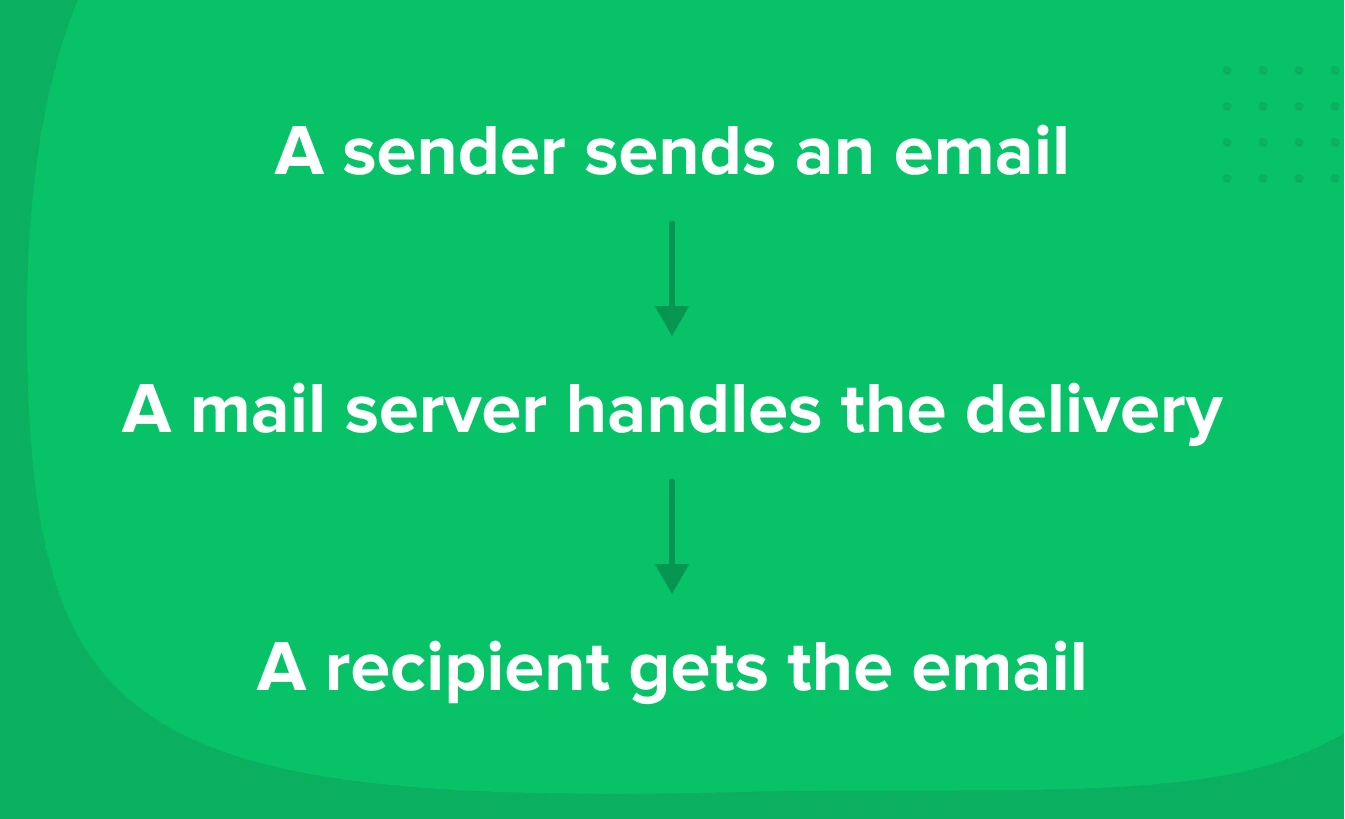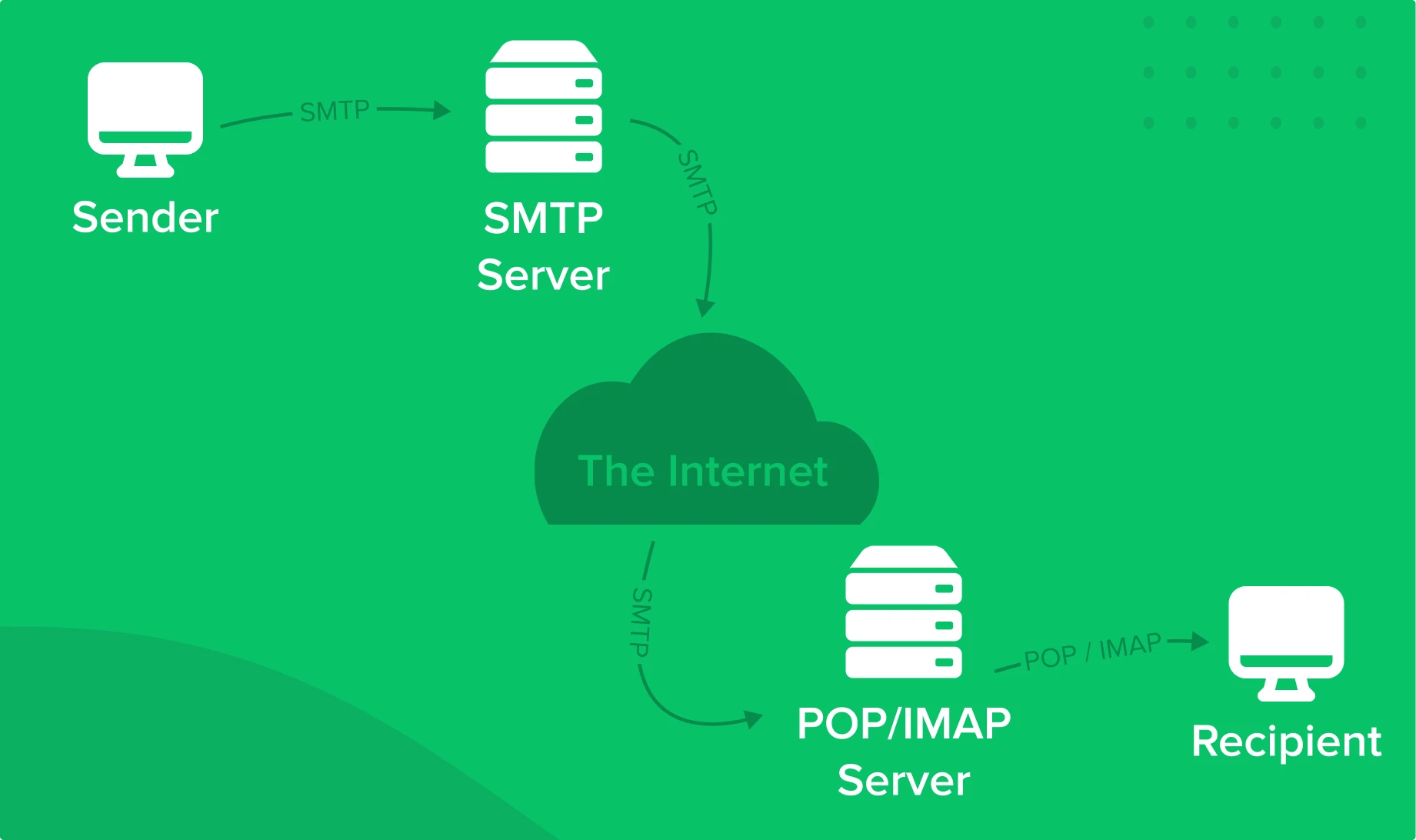What are email protocols and how to choose the right one

SMTP, POP, IMAP… What? This question probably comes to mind when you see these words. All these scary abbreviations are, in fact, crucial for delivering emails. They are known as email protocols.
Whether you are a business owner or a marketer, it's valuable to know the differences between SMTP, POP3, IMAP4 and their roles in the process of transmitting electronic letters.
Today, we are going to share all the relevant details of email protocols in plain language. (And you’ll realize they’re not so scary after all!) But first, let's start by understanding a bit more about how the process of sending emails works (also known as “email infrastructure”) and the most important aspects of it. Let’s go!
What “email infrastructure” means
When you hit the “send” button to deliver an email marketing campaign or a personal email message, you don't think about how your message will get to the recipient. You only care about your emails actually landing in your recipients’ inboxes. However, both of these activities—transfer and reach—rely on email infrastructure.
Email infrastructure is a process consisting of a few components like:
Domain Name System (DNS)
Internet Protocol (IP) addresses
Mail Transfer Agents (MTA)
The leading role of each is to ensure smooth email transportation. That means it is their job to deliver every newsletter and/or transactional email you send out.
Why email protocols are important
The email transfer process can be simply explained through this flow:

From an infrastructure perspective, email protocols establish the connection between these 3 elements. From the user's perspective, email protocols are simply the ones responsible for a sent email reaching a recipient inbox.
Email protocols are a crucial part of ensuring email deliverability. They work alongside methods like email authentication, spam scoring and blacklisting to make it happen. In essence, they are those arrows above—the needle that moves your emails to people’s inboxes.
Since there are senders and receivers, email protocols activate the flow for outgoing emails (outbound) and incoming emails (inbound), respectively.
Let's view each of these methods, starting with the king of outbound protocols: SMTP.
1. What is SMTP?
SMTP stands for Simple Mail Transfer Protocol and is responsible for only sending emails in the Transmission Control Protocol / Internet Protocol suite model (TCP/IP). MTAs use this solution to transmit messages between servers.
The functionality of SMTP is command-based. There are basic commands like HELO, MAIL FROM, and many others. SMTP commands are used to identify the sender, the receivers, the message itself and establish the connection between email servers. Also, this protocol monitors the frequency of sending to avoid the email flood in a recipient inbox.
Simply speaking, you want to:
1. Send a newsletter
2. Choose your recipients
3. Press the 'Send’ button.
With this operation, an outgoing email goes to your SMTP server. Then, with the help of MTAs, your email gets to a receiving server through the network. After that, your email uses a receiver (inbound) protocol to get to recipients’ inboxes.

What are the SMTP server ports
In terms of email infrastructure, ports are responsible for how emails go through the network. For instance, they could go in a general route, via an encrypted way, and so on.
There are 4 SMTP ports:
Port 25: An old school port, but some email clients block it due to low-security
Port 465: A port for SMTPS (secured), but now it's rarely used
Port 587: A common encrypted and secured port used by all email clients
Port 2525: A secured and modern version of port 25; many consider it the best option
It may look technical, but don't worry: most email clients and marketing automation services have configured the SMTP protocol and encrypted ports. In case you want to set up everything, you should fill in all the SMTP credentials (sender and server name) in the mail client settings and choose a port—587 or 2525 are recommended.
Data privacy and cybersecurity are hot issues. So it's better to use modern SMTP ports with encryption and additional security layers to prevent data breaches, email frauds or other forms of cybercrime. Learn more about SMTP ports.
2. What is POP?
Post Office Protocol (POP) is the first of two inbound email protocols. The third version of it—POP3—is currently the most popular. This protocol gets and downloads emails from the server to recipients' inboxes. POP3 is the standard for receiving emails.
Its flow is also simple: After you send a transactional email, SMTP does the sending part. POP3 reaches the mail server, grabs the message and forwards it to a recipient inbox.
The critical detail and difference about POP3 is that it downloads messages and they're deleted from the server immediately. This is the biggest perk of POP3—it doesn't rely on an Internet connection when the message is downloaded; you can reach it even when you’re offline. Its primary shortcoming is that you can't check the same email from different devices, since it can only be downloaded by one of them.
POP3 has 2 ports:
Port 101: A default port
Port 995: A secured and encrypted option
As you might guess, the latter one is preferable in 2021.
3. What is IMAP?
Internet Message Access Protocol (IMAP) is the second inbound email protocol.
Currently, IMAP4 (4th version) is the most used version. Its main task is to get emails from the server to inboxes. However, IMAP4 doesn't delete an email from the server as POP3 does. It allows you to reach your emails from various devices.
IMAP’s functionality is command-driven and based on these 3 steps:
When you receive a new email, your email client connects to the server.
A message preview is enabled, you can see the email subject line and sender name.
After you open the email, IMAP downloads it.
In terms of ports, IMAP4 offers:
Port 143: The default one
Port 993: Known as IMAP, it’s a secured port preferred by email clients
Overall, IMAP4 has become an efficient solution for teams that handle multiple email inboxes and require synchronization between several devices, which is pretty common these days.
POP vs IMAP
When comparing POP3 and IMAP4, keep in mind that most modern email clients support both of them. Moreover, these two protocols have TLS/SSL encrypted ports enabled.
In terms of Internet connectivity, POP3 is the winner. Meanwhile, IMAP4 strongly depends on a good connection and the uninterrupted work of servers.
To get more details and distinguishing features, check this article on the difference between POP and IMAP.
Which email protocol to choose
At this point, you now know that there is one protocol to send emails (SMTP) and two protocols to receive them (POP3 and IMAP4). Now the question is how to select the correct set of them.
If you want to try a new email marketing tool, automation or testing solution, or you just want to configure an email client for the sake of your own privacy, here's how to know which port to pick.
SMTP should be your choice simply because it's the only email sending protocol. It's an essential component of your email infrastructure—without it, you wouldn't be able to send any type of transactional or marketing emails. So your task becomes selecting the most suitable SMTP port. As previously mentioned, we’d recommend you have a preference for encrypted ports over standard ones.
When it comes to receiving protocols, implementing two of them is your best option. However, you can use POP3 for small teams or one-person businesses. This protocol is a good fit for companies that are highly focused on security and privacy, since emails aren't stored on any servers after they've been opened. If you don't need to constantly check your emails, then you could consider this protocol—you'll have one inbox with exclusive access.
IMAP4 is the protocol of choice for growing teams and big companies that promote speed of delivery and accessibility. This protocol works well with shared inboxes and reply-focused activities. Consider this protocol if your focus is on response time.
Wrapping up
Email protocols are considered a technical topic, but it's essential knowledge to help you understand better how sending and receiving emails work.
To recap, remember that SMTP is essential for sending emails. POP3 will help you receive emails adding more privacy to this process. And finally, IMAP4 fits the modern pace of accessibility.
When choosing your set of email protocols, remember to pick secured ports and stick to your business goals.

Dmytro Zaichenko is a Digital Marketing Specialist at Mailtrap, an email sandbox service that helps test emails in the development environment securely. Besides communicating and collaborating with interesting people, he's passionate about writing and has 6+ years of experience in content making. His other immense love is the game of basketball. Feel free to reach Dmytro via LinkedIn.
